Campaign Against the Japan-U.S. Security Treaty (安保闘争/Anpo Protest)
→60年安保 (Anpo 60s)
May 20th, 1960: The Shinsuke Kishi Liberal Democratic Party cabinet overcame the Socialist Party, the Communist Party against the ratification of Treaty of Mutual Cooperation and Security Between the United States and Japan by steamrolling (日米安保条約改定). The opposition movement for the steamrolling became active even outside of the Diet and an intense demonstration was repeated. This is how 安保闘争(campaign against the Japan-U.S. Security Treaty/Anpo Protest) started.
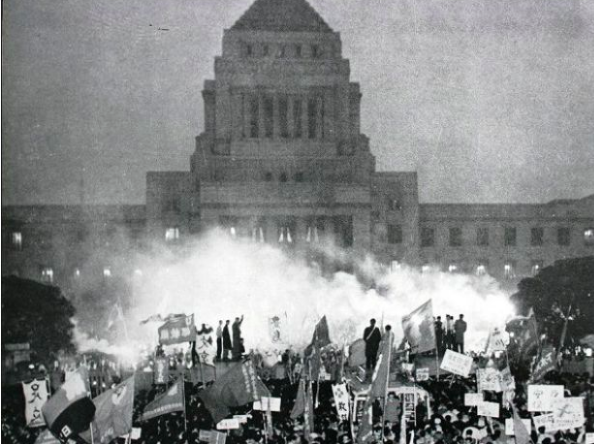
June 15th, 1960: Michiko Kanba, a student of the University of Tokyo, died in clashes between demonstrators and police at the South Gate of the National Diet Building in Kasumigaseki (日米安保条約改定). Also a large number of people were injured.This event describes an aggressive atmosphere of protest in post-war Japan, which draws a contrast to the current state of protesters and their organized manner in the anti-government activity. The death of Kanba Michiko evokes trauma to both protesters and authority that is obligated to oppress and shut the aggressive protesting activities leading to the current state, which we have found in field work, where both police and protestors are mutually agreeing on creating the peaceful and organized environment in the act of protest.
June 19th, 1960: The treaty was concluded, but the Eisenhower’s visit to Japan was cancelled because of the opposition movement and the Cabinet resigned after the treaty was concluded (日米安保条約改定).
This opposition movement was not only held by the Socialist Party, the Communist Party and the existing reformist party, but also labor unions,students,other people including housewives participated in the movement. Demonstrators surrounded the Diet building day after day and enlarged it in an unprecedented scale.
→70年安保 (Anpo 70s)
The security treaty expires after 10 years; therefore, people started protests to prevent the renewal of the security treaty. “70 security treaty crush” was developed as a slogan and demonstrations were held nationwide, mostly by students (Oguma).
October 1967: A small group of activists clashed with police near Tokyo’s Haneda Airport to prevent Prime Minister Sato Eisaku from traveling to South Vietnam (Oguma). Students were wearing “plastic construction helmets and a gewalt stick,” which was the style of the protest during those days. At the protest, one student activist was killed.
June 1968: Students at the University of Tokyo and Nihon University with approximately one-tenth of Japan’s total university student population, established Zenkyoto (“All-Campus Joint Struggle Councils”). They were wearing “plastic construction helmets and a gewalt stick,” and they seized and barricaded their campuses against police intrusion (Oguma). They through rocks and flammable grenade. Zenkyoto was independent from the other organizations and open to any willing participants, regardless of ideological affiliation. The barricaded universities were declared “liberated zones,” and the image of students resisting police in the name of greater academic and personal freedom were spread through media. This event is called “Zenkyoto movement” which campus occupations continued from mid-1968 through early 1969.
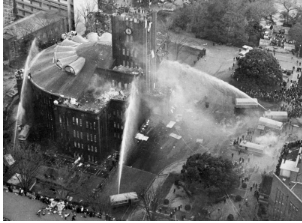
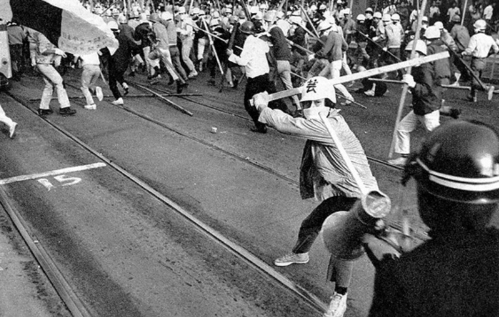
June 1970: The student movements was almost entirely suppressed by the police. The Security Treaty was renewed.
Because it was unable to prevent the renewal of the security treaty and it caused deaths and injuries, people were discouraged and the number of the civic participation of the political movement declined and young people lost their interest in politics. Probably, it was the end of aggressive protests in Japan.
Koenji Demonstrations
Koenji demonstrations were started by Hajime Matsumoto, an owner of 素人の乱 (Recycle Shop). He was born in 1974, after Anpo Protest; therefore, his activities are totally different from Anpo (松本). The shape of demonstration changed.
2005: Hajime Matsumoto opened his recycle shop 素人の乱(shirouto no ran) and he started to organize demonstrations in Koenji such as “give me back my bike,” “against PSE law,” “make house rent free,” and more.
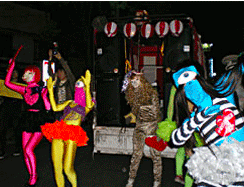
According to Misao Redwolf, it was led by leftist artists and focus was much more on anarchism and subculture. Demonstrations were much more creative and festive rather than political compared to protests in the past. It was entertainment based. The focus was on anarchism and independence rather than politics and message towards politician.
Anti-Nukes
On March 11, 2011, The Great East Japan Earthquake occured. A 15-metre tsunami disabled the power supply and cooling of three Fukushima Daiichi reactors, which caused a nuclear accident (Fukushima Daiichi Accident).
11 March, 2011:
- 14:46 The Great East Japan Earthquake occurred.
- 15:42 TEPCO made the first emergency report to the government.
- 19:03 The government announced nuclear emergency.
- 20:50 The Fukushima Prefecture Office ordered 2km radius evacuation.
- 21:23 The government ordered 3km evacuation and to keep staying inside buildings in the area of 3-10km radius.
- 05:44 The government ordered 10km radius evacuation.
- 18:25 The government ordered 20km evacuation.
(Fukushima Daiichi Accident)
21 April, 2011: The government set the 20km radius no-go area.
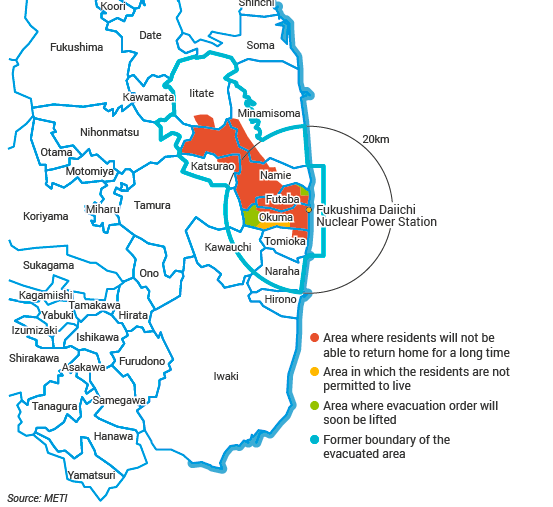
(Fukushima Daiichi Accident)
And to this day, there are still a lot of people who cannot go back to their houses, because everything is contaminated including house, water, plants, and etc, which can cause health problems such as cancers due to radiation exposure.
This accident made people rethink of using a nuclear energy, and right after the accident, the protest against nuclear energy started everywhere in Japan by the wide range of people.
September 2011:Metropolitan Coalition Against Nukes was formed with groups and individuals who want to see a safer and brighter future for Japan, by terminating the use of nuclear power energy (首都圏反原発連合とは). They actively organize peaceful marches, rallies and other public events spreading information about why the nuclear power industry must be stopped.
11 September 2011: According to Misao Redwolf, protests in Kasumigaseki were at first, held in the front of Ministry of Economy Trade and Industry by Metropolitan Coalition Against Nukes to ask them to eliminate the Nuclear Power Plant. About 100~200 people participated. People were protesting peacefully, nothing aggressive.
19 March 2012: The first “官邸前抗議”(protest in the front of the Prime Minister’s official residence) was held. The protest location changed to the Prime Minister’s official residence, because the Ohi nuclear power plant machine test was passed in the ministry and now the decision of whether to re-operate the machine was about to be made in the Prime Minister’s official residence by the Cabinet members. The protest was specifically against the restart of the Ohi nuclear power plant; therefore, they shouted toward the building, so that the Cabinet members can hear, but nothing more than shouting (Redwolf).
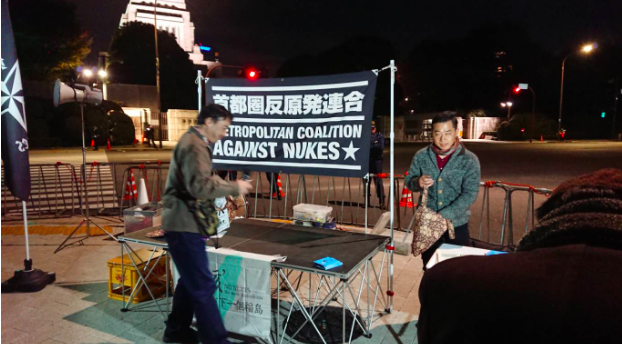
This “官邸前抗議” continues to this day. It is held every Friday night at the front of the Prime Minister’s office and the Diet Building. Metropolitan Coalition Against Nukes have shaped the current style of protest.
SEALDs
March 2015: SEALDs (Students Emergency Action for Liberal Democracy ) were organized to protest against Prime Minister Abe’s efforts to pass the State Secrecy Acts, the “reinterpretation” of Article 9 of the Constitutions and the Security Bills (Slater).
Metropolitan Coalition Against Nukes paved the way for SEALDs.
July 2015: SEALDs started to hold its demonstrations in Kasumigaseki every Friday nights. The anti-nuke demonstrations were held in front of the Prime Minister’s Residence while SEALDs assemble at the front of the National Diet Building. Metropolitan Coalition Against Nukes’ experience of protesting every week in Kasumigaseki for four years taught people that they can hold a protest in Kasumigaseki, the center of state power as long as if it is peaceful (Slater).
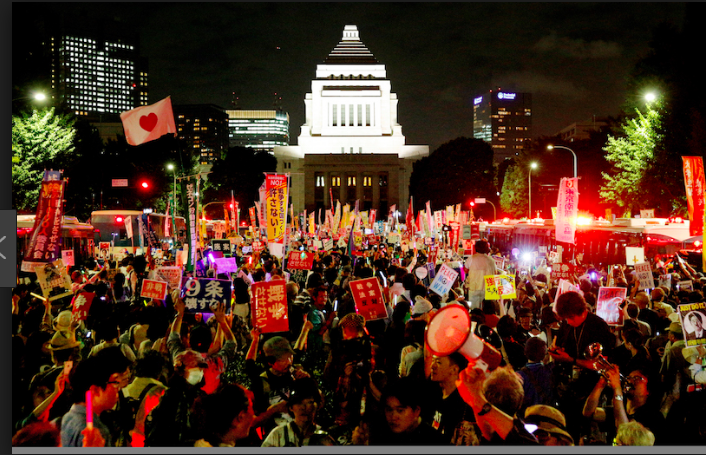
The style of protests changed over time, and the Metropolitan Coalition Against Nukes continues to shape and iterate upon the culture of protest.
MU